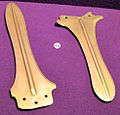 | |
| Geographical range | Romania, Bulgaria |
|---|---|
| Period | Bronze Age |
| Dates | c. 2000 BC – 14th century BC |
| Preceded by | Glina-Schneckenberg culture |
| Followed by | Noua-Coslogeni culture, Wietenberg culture |
The Tei culture was a Bronze Age archaeological culture located in southern Romania and northern Bulgaria, dating from c. 2000 BC to the 14th century BC. It was preceded by the Glina-Schneckenberg culture and succeeded by the Noua-Coslogeni culture, and was contemporary with the related Monteoru culture. [1]



